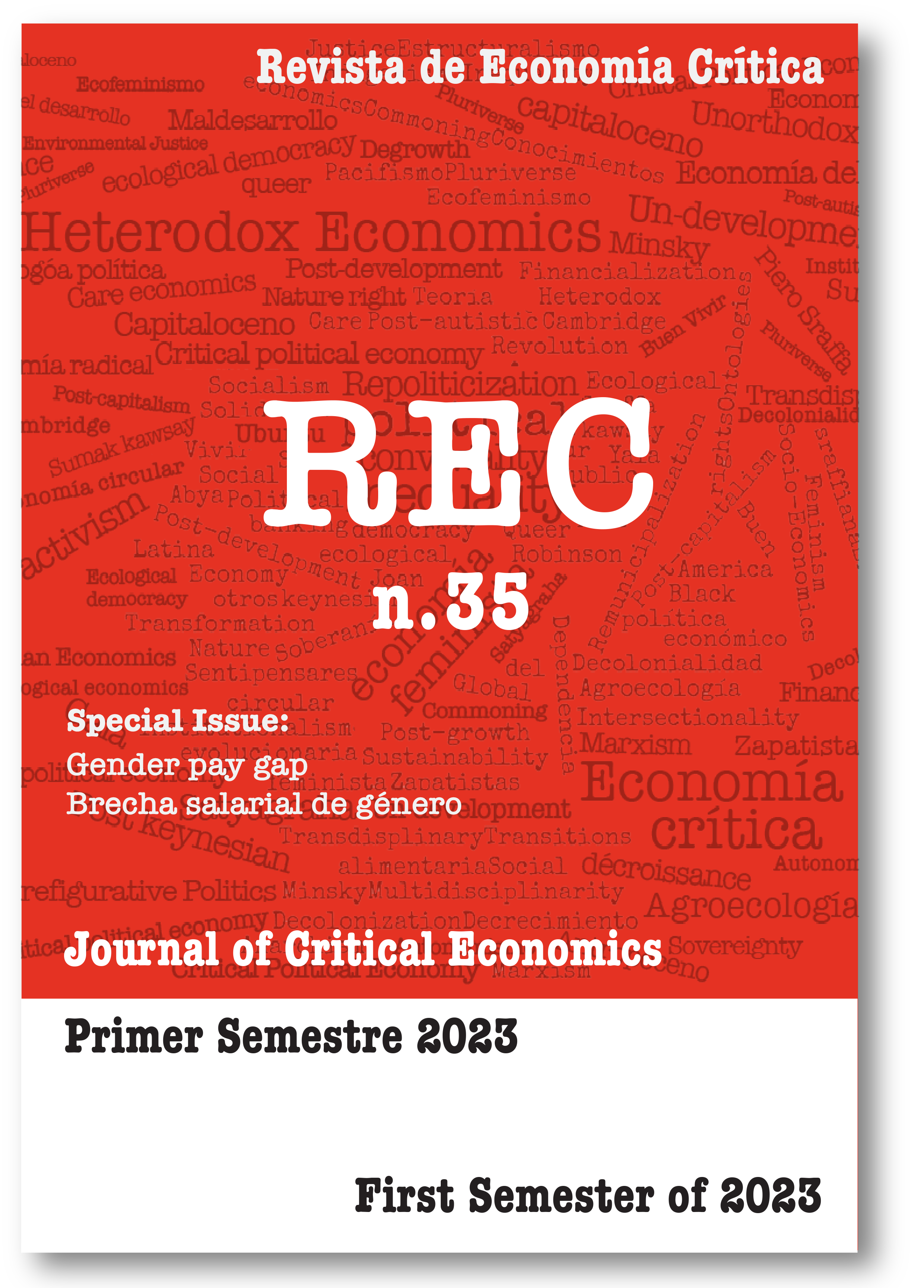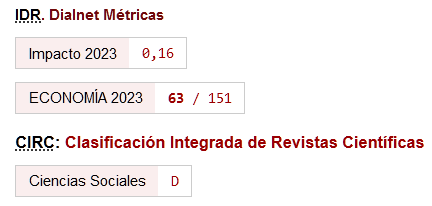Measurement of the gender salary gap
an approach through the literature review
DOI:
https://doi.org/10.46661/rec.8969Keywords:
Pay gap literature review, Gender pay gap, Equal pay, Indirect discrimination, Oaxaca-BlinderAbstract
The pay gap can have a pay inequality origin, in this case women would receive a different payment for doing the same work or work of equal value as men, but this discriminatory treatment is legally sanctioned and is considered a crime if it is applied to people based on their sex. It is therefore important to understand that the concept of the gap is much broader, and includes other factors that explain wage inequality, such as the feminization of part-time jobs or the well-known glass ceiling. Since the wage gap is a fact, to combat it it is necessary to quantify it, to determine what mathematical model underlies the different gross hourly wages of men and women, what variables are used in these calculations and whether there are different methodologies to be applied. The main objective of the article is to carry out a systematic review report on the existing research on wage gap calculation methodology in order to compile the theories that quantify the gender wage gap, explain its reasons and promote different solutions to eradicate it. After carrying out this review, it can be seen that there is no unanimous consensus in the research community on the breakdown of the gender pay gap, but all the studies agree that the pay gap is not only explained by the differences in the characteristics of men and women; there is also a residual part of greater or lesser amount that would come to represent the labor and wage discrimination experienced by women in the labor market.
Downloads
References
Alonso, N., & Trillo, D. (2021). La crisis del estado de bienestar y sus repercusiones sobre la situación sociolaboral de las mujeres. Revista de Economía Crítica, 20(2), 135-154.
Alonso, N., & Gutiérrez, I. (2023). Gender and organizational culture in the European Union: situation and prospects. Frontiers in Psychology, 14, 1164516. https://doi.org/10.3389/fpsyg.2023.1164516 DOI: https://doi.org/10.3389/fpsyg.2023.1164516
Asamblea General de las Naciones Unidas. (1981). Convención sobre la eliminación de todas las formas de discriminación contra la mujer. Nueva York.
Anker, R., Melkas, H., & Korten, A. (2003). Gender-based occupational segregation in the 1990s. International Labour Office.
Arnau Sabatés, L., & Sala Roca, J. (2020). La revisión de la literatura científica: Pautas, procedimientos y criterios de calidad. Barcelona: Universitat Autònoma de Barcelona.
Arrow, K. (1971). The theory of discrimination. In Discrimination in Labor Markets (pp. 88-112). Princeton: Princeton University Press.
Bakker, I. (1995). The Strategic Silence: Gender and Economic Policy. Zed Books.
Barbezat, D., & Hughes, J. W. (2005). Salary Structure Effects and the Gender Pay Gap in Academia. Research in Higher Education, 46(6), 621-640. https://doi.org/10.1007/s11162-004-4137-1 DOI: https://doi.org/10.1007/s11162-004-4137-1
Becker, G. (1957). The economics of discrimination. Chicago: University of Chicago Press.
Becker, G. (1964). Human Capital. New York: National Bureau of Economic Research.
Benavente Torres, I., Muñoz Molina, J., Rodríguez Copé, M. L., Rodríguez Crespo, M. J., & Sáez Lara, C. (2016). Igualdad de género en el trabajo: estrategias y propuestas. Ediciones Laborum.
Benería, L. (1979). Reproduction, production and the sexual division of labour. Cambridge Journal of Economics, 3(3), 203-225.
Benería, L. (1995). Toward a Greater Integration of Gender in Economics. World Development, 23(11), 1839-1850. https://doi.org/10.1016/0305-750X(95)00095-T DOI: https://doi.org/10.1016/0305-750X(95)00095-T
Blau, F., & Kahn, L. M. (1994). Rising Wage Inequality and the U.S. Gender. The American Economic Review, 84(2), 23-28.
Blau, F., & Kahn, L. M. (1995). Wage Structure and Gender Earnings Differentials: An International Comparison. Economica, 63, 29-62. https://doi.org/10.2307/2554808 DOI: https://doi.org/10.2307/2554808
Blau, F., & Kahn, L. M. (2000). Gender differences in pay. Journal of Economic Perspectives, 14(4), 75-99. https://doi.org/10.1257/jep.14.4.75 DOI: https://doi.org/10.1257/jep.14.4.75
Blinder, A. S. (1973). Wage discrimination: reduced forms and structural estimates. Journal of Human Resources, 436-455. https://doi.org/10.2307/144855 DOI: https://doi.org/10.2307/144855
Boote, D., & Beile, P. (2005). Scholars before Researchers: On the Centrality of the Dissertation Literature Review in Research Preparation. Educational Research, 6(34), 3-15. https://doi.org/10.3102/0013189X034006003 DOI: https://doi.org/10.3102/0013189X034006003
Comisión Europea. (2020). Una Unión de la igualdad: Estrategia para la Igualdad de Género 2020-2025. Bruselas.
Comunidad Europea. (10 de noviembre de 1997). Tratado de Ámsterdam. Tratado de Ámsterdam. Ámsterdam, Países Bajos: Diario Oficial de las Comunidades Europeas.
Croson, R., & Gneezy, U. (2009). Gender Differences in Preferences. Journal of Economic Literature, 2(47), 1-27. https://doi.org/10.1257/jel.47.2.448 DOI: https://doi.org/10.1257/jel.47.2.448
Darity, W. A., & Mason, P. (1998). Evidence on Discrimination in Employment: Codes of Color, Codes of Gender. Journal of Economic Perspectives, 12(2), 63-90. https://doi.org/10.1257/jep.12.2.63 DOI: https://doi.org/10.1257/jep.12.2.63
De Cabo Serrano, G., & Garzón, M. J. (2007). Diferencia y discriminación salarial por razón de sexo. Madrid: Instituto de la Mujer.
Del Río, C., Gradín, C., & Cantó, O. (2004). El enfoque distributivo en el análisis de la discriminación salarial por razón de género. Documento de trabajo 0405, departamento de Economía Aplicada, Universidad de Vigo.
Dueñas, D., Iglesias, C., & Llorente, R. (2014). Descomposición del Gap salarial por género en el mercado de trabajo español. Aportaciones a la investigación sobre mujeres y género: V Congreso Universitario Internacional "Investigación y Género". Sevilla.
Gamero Burón, C. (2004). Satisfacción laboral de los asalariados en España. Especial referencia a las diferenecias por género. Cuadernos de economía, 27(74), 109-146.
García, C., Prieto, M., & Simón, H. (2014). La modelización paramétrica de las distribuciones salariales. Revista de economía aplicada, 22(65), 5-38.
García-Peñalvo, F. J. (2022). Desarrollo de estados de la cuestión robustos: Revisiones Sistemáticas de Literatura. Education in the Knowledge Society (EKS), 23. https://doi.org/10.14201/eks.28600 DOI: https://doi.org/10.14201/eks.28600
Gardeazabal, J., & Ugidos, A. (2005). Gender wage discrimination at quantiles. Journal of Population Economics, 18(165), 65-179. https://doi.org/10.1007/s00148-003-0172-z DOI: https://doi.org/10.1007/s00148-003-0172-z
Grant, M. J., & Booth, A. (2009). A typology of reviews: an analysis of 14 review types and associated methodologies. Health Information and Libraries Journal, 26, 91-108. https://doi.org/10.1111/j.1471-1842.2009.00848.x DOI: https://doi.org/10.1111/j.1471-1842.2009.00848.x
Guevara Patiño, R. (2016). El estado del arte en la investigación: ¿análisis de los conocimientos acumulados o indagación por nuevos sentidos? Folios: revista de la Facultad de Humanidades(44), 165-179. https://doi.org/10.17227/01234870.44folios165.179 DOI: https://doi.org/10.17227/01234870.44folios165.179
Guirao Goris, S. J. A. (2015). Utilidad y tipos de revisión de literatura. 9(2). https://doi.org/10.4321/S1988-348X2015000200002 DOI: https://doi.org/10.4321/S1988-348X2015000200002
Heckman, J. J. (1979). Sample Selection Bias as a Specification Error. Econometrica, 47, 153-161. https://doi.org/10.2307/1912352 DOI: https://doi.org/10.2307/1912352
Hernández, P. J., & Méndez, I. (2005). La corrección del sesgo de selección en los análisis de corte transversal de discriminación salarial por sexo: estudio comparativo en los países de la Unión Europea. Estadística Española, 47(158), 179-214.
Lalovic, M. (24 de junio de 2019). The gender pay gap: where to start? Obtenido de Social Europe: https://www.socialeurope.eu/the-gender-pay-gap
Instituto Nacional de Estadística (INE). (2022). Encuesta de Población Activa. Cuarto trimestre 2022. Madrid: Instituto Nacional de Estadística.
León Camargo, A. (2020). Literatura de la brecha salarial de género. 5° Congreso Internacional sobre Desigualdad Social, Género y Precarización: Mujeres en acción. México.
Lewbel, A. (2002). Selection Model and Conditional Treatment Effects. Boston College Working Papers in Economics.
Marín Malo, M. (2021). Discriminación salarial indirecta y los sistemas de valoración de puestos de trabajo. Femeris, 6(2), 34-60. https://doi.org/10.20318/femeris.2021.6135 DOI: https://doi.org/10.20318/femeris.2021.6135
Mill, J. S. (1848). Principles of Political Economy.
Mincer, J. (1962). Labor Force Participation of Married Women: A Study of Labor Supply. En Aspects of Labor Economics (págs. 63-105). National Bureau of Economic Research, Inc.
Murillo Huertas, I., & Simón Pérez, H. (2014). La Gran Recesión y el diferencial salarial por género en España. Hacienda Pública Española/Review of Public Economics(208), 39-79. https://doi.org/10.7866/HPE-RPE.14.1.2 DOI: https://doi.org/10.7866/HPE-RPE.14.1.2
Neuman, S., & Oaxaca, R. L. (2003). Estimating Labor Market Discrimination with Selectivity-Corrected Wage Equations: Methodological Considerations and An Illustration from Israel. The Pinhas Sapir Center for Development, Tel-Aviv University. Discussion Paper nº 2. https://doi.org/10.1023/B:JOEI.0000028395.38694.4b DOI: https://doi.org/10.1023/B:JOEI.0000028395.38694.4b
Neumark, D. (1988). Employer's Discriminatory Behavior and the Estimation of Wage Discrimination. The Journal of Human Resources, 23, 279-295. https://doi.org/10.2307/145830 DOI: https://doi.org/10.2307/145830
Oaxaca, R. L. (1973). Male-female wage differentials in urban labour markets. International Economic Review(14), 693-709. https://doi.org/10.2307/2525981 DOI: https://doi.org/10.2307/2525981
Organización de las Naciones Unidas. (1995). Declaración de Beijing. Informe de la Cuarta Conferencia Mundial sobre la Mujer. Pekín. Obtenido de https://www.unwomen.org/es/digital-library/publications/2015/01/beijing-declaration
Organización de las Naciones Unidas. (14 de septiembre de 2020). ONU Mujeres. Obtenido de https://www.unwomen.org/es/news/stories/2020/9/explainer-everything-you-need-to-know-about-equal-pay
Organización Internacional del Trabajo. (1951). Convenio sobre igualdad de remuneración. Ginebra.
Organización Internacional del Trabajo. (1958). Convenio sobre la discriminación (empleo y ocupación). Ginebra.
Organización Internacional del Trabajo. (2023). Perspectivas Sociales y del Empleo en el Mundo. Tendencias 2023. Ginebra.
Palacios Gómez, J. L. (2018). Cuando los números hablan. Análisis y valoración de la estadística oficial de discriminación salarial por razón de sexo en España (2005-2016). Sociología del Trabajo(93), 221-242. https://doi.org/10.5209/STRA.61717 DOI: https://doi.org/10.5209/STRA.61717
Randolph, J. (2009). A Guide to Writing the Dissertation Literature Review. Practical Assessment, Research, and Evaluation, 14(13), 1-13.
Sáez Lara, C. (1995). Las discriminaciones indirectas en el trabajo. Cuadernos de Relaciones Laborales(6).
Sáez Lara, C. (2020). Registro salarial e igualdad retributiva entre mujeres y hombres en el RDL 6/2019: Una primera aproximación. Derecho Social y Empresa(12). DOI: https://doi.org/10.18172/redsye.6203
Van Laere, C. F. (1998). Concepto de igualdad y discriminación directa e indirecta en la normativa y jurisprudencia en distintos países. El caso de Bélgica. Jornadas sobre "La igualdad de oportunidades entre mujeres y hombre en el ámbito laboral". Instituto de la Mujer.
Vela Menéndez, L., González Crus, K. A., & Castillo Seminario, L. (2021). La brecha salarial de género. Una revisión de literatura. ESPERGESIA: Revista Literaria y de Investigación, 8(2), 62-70. https://doi.org/10.18050/rev.espergesia.v8i2.857 DOI: https://doi.org/10.18050/rev.espergesia.v8i2.857
Downloads
Published
How to Cite
Issue
Section
License
Copyright (c) 2023 Irene Gutiérrez López

This work is licensed under a Creative Commons Attribution 4.0 International License.
This licence allows third parties to share (copy and redistribute the material in any medium or format) and adapt (remix, transform and create from the material for any purpose, including commercial purposes), provided that authorship and first publication in this journal (The Journal, DOI of the work) is acknowledged, a link to the licence is provided, and it is stated whether changes have been made to the work.







